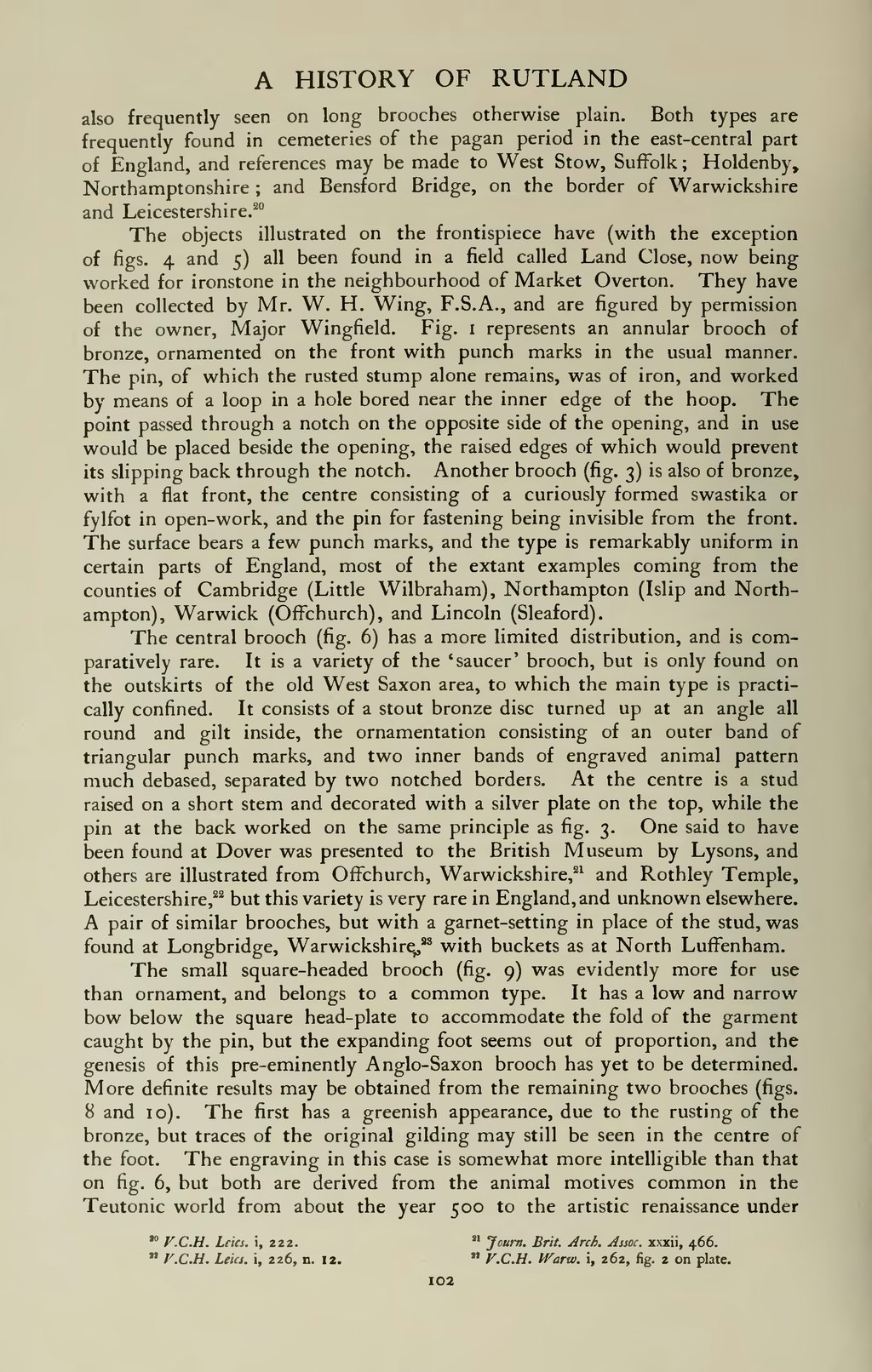A HISTORY OF RUTLAND also frequently seen on long brooches otherwise plain. Both types are frequently found in cemeteries of the pagan period in the east-central part of England, and references may be made to West Stow, Suffolk ; Holdenby, Northamptonshire ; and Bensford Bridge, on the border of Warwiclcshire and Leicestershire.-" The objects illustrated on the frontispiece have (with the exception of figs. 4 and 5) all been found in a field called Land Close, now being worked for ironstone in the neighbourhood of Market Overton. They have been collected by Mr. W. H. Wing, F.S.A., and are figured by permission of the owner, Major Wingfield. Fig. i represents an annular brooch of bronze, ornamented on the front with punch marks in the usual manner. The pin, of which the rusted stump alone remains, was of iron, and worked by means of a loop in a hole bored near the inner edge of the hoop. The point passed through a notch on the opposite side of the opening, and in use would be placed beside the opening, the raised edges of which would prevent its slipping back through the notch. Another brooch (fig. 3) is also of bronze, with a flat front, the centre consisting of a curiously formed swastika or fylfot in open-work, and the pin for fastening being invisible from the front. The surface bears a few punch marks, and the type is remarkably uniform in certain parts of England, most of the extant examples coming from the counties of Cambridge (Little Wilbraham), Northampton (Islip and North- ampton), Warwick (Offchurch), and Lincoln (Sleaford). The central brooch (fig. 6) has a more limited distribution, and is com- paratively rare. It is a variety of the 'saucer' brooch, but is only found on the outskirts of the old West Saxon area, to which the main type is practi- cally confined. It consists of a stout bronze disc turned up at an angle all round and gilt inside, the ornamentation consisting of an outer band of triangular punch marks, and two inner bands of engraved animal pattern much debased, separated by two notched borders. At the centre is a stud raised on a short stem and decorated with a silver plate on the top, while the pin at the back worked on the same principle as fig. 3. One said to have been found at Dover was presented to the British Museum by Lysons, and others are illustrated from Offchurch, Warwickshire,"^ and Rothley Temple, Leicestershire,*^^ but this variety is very rare in England, and unknown elsewhere. A pair of similar brooches, but with a garnet-setting in place of the stud, was found at Longbridge, Warwickshire/^ with buckets as at North Luffenham. The small square-headed brooch (fig. 9) was evidently more for use than ornament, and belongs to a common type. It has a low and narrow bow below the square head-plate to accommodate the fold of the garment caught by the pin, but the expanding foot seems out of proportion, and the genesis of this pre-eminently Anglo-Saxon brooch has yet to be determined. More definite results may be obtained from the remaining two brooches (figs. 8 and 10). The first has a greenish appearance, due to the rusting of the bronze, but traces of the original gilding may still be seen in the centre of the foot. The engraving in this case is somewhat more intelligible than that on fig. 6, but both are derived from the animal motives common in the Teutonic world from about the year 500 to the artistic renaissance under '" F.C.H. Leics. i, 222. *' Journ. Brit. Arch. Assoc, xxxii, 466. " F.C.H. Leics. i, 226, n. 12. *' F.C.H. IFarzv. i, 262, fig. 2 on plate. 102
